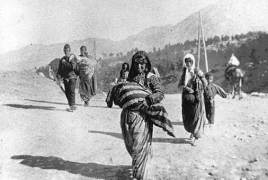How Armenian woman set fire to Turks who killed her family in 1915 PanARMENIAN.Net - Gohar Aselesian in 2015 presented to ArmenianGenocide100.org the story of her grandmother, Hayastan, who was married to a wealthy merchant in 1915 and had two sons, aged 3 and 5. During the Armenian Genocide, first her husband was murdered, and when she screamed at her children, making them run away, a Turk caught and decapitated them right before her eyes. The woman tried to escape herself, but enchanted by her beauty, the Turk caught her and dragged her to the barn. Her story reads: “The story I am about to tell is based on real events, which I have heard from grandmother Hayastan. She was married to a wealthy merchant in 1915 and had two sons, aged 3 and 5. First her husband was murdered, and when she screamed at her children, making them run away, a Turk caught and decapitated them right before her eyes. The woman tried to escape herself, but, enchanted by her beauty, the Turk caught her and dragged her to the barn… “When I recovered consciousness, I found 6-7 Turks sleeping inside the barn. I left quietly, locked the door and set the barn on fire. I can still hear those animals’ screams. I walked and ran for a long time, until I reached Agin,” the grandmother recounted. The brave woman thus managed to get revenge against the murderers of her family. Everybody in Agin knew about the beautiful Armenian woman who had survived the Turks’ slaughter, but nobody managed to find or see her during the whole winter. When grandmother Hayastan had more or less got over the deaths of her loved ones, she took buckets on a spring day and went to get some water. It was there that she met grandfather Yervand, an educated and influential man, who immediately fell in love with her. Thus, the story of Galstian family started… Grandmother Hayastan became pregnant again, had children, grandchildren, great grandchildren, all of whom, by the way, inherited her beauty. She lived all her life and never forgot the atrocities she had gone through. I will never forget the day she breathed her last… She remembered her children, murdered by Turks, cursed those criminals, or laughed and cried like crazy."  The Armenian Genocide The Armenian Genocide (1915-23) was the deliberate and systematic destruction of the Armenian population of the Ottoman Empire during and just after World War I. It was characterized by massacres and deportations, involving forced marches under conditions designed to lead to the death of the deportees, with the total number of deaths reaching 1.5 million. The number of state universities will be reduced from 23 to 8 by 2030, Minister of Education, Science, Culture and Sport Zhanna Andreasyan has said. From September 21 to November 11, a total of 2,820 Russians registered at a place of residence in Armenia, the police has said. The situation on the contact line between Karabakh and Azerbaijan was relatively stable overnight, the Defense Army says. Defense Minister Suren Papikyan has visited the southern Armenian province of Syunik, the Defense Ministry reported on March 18. Partner news |